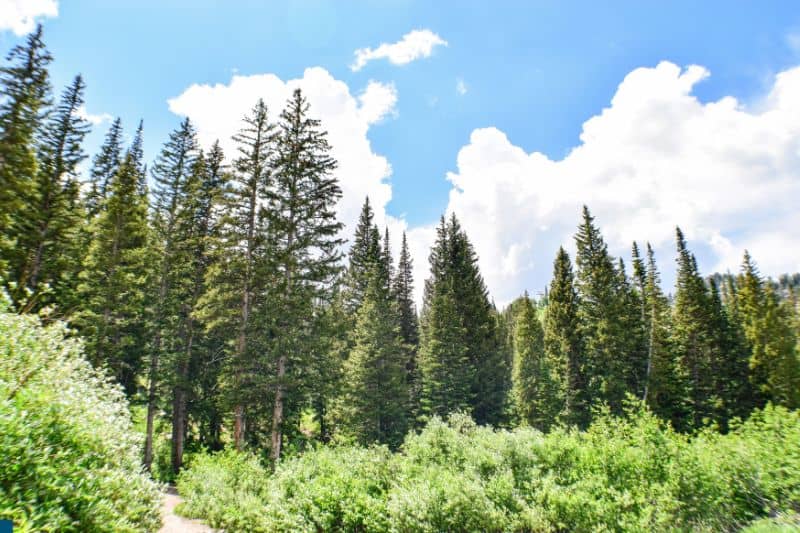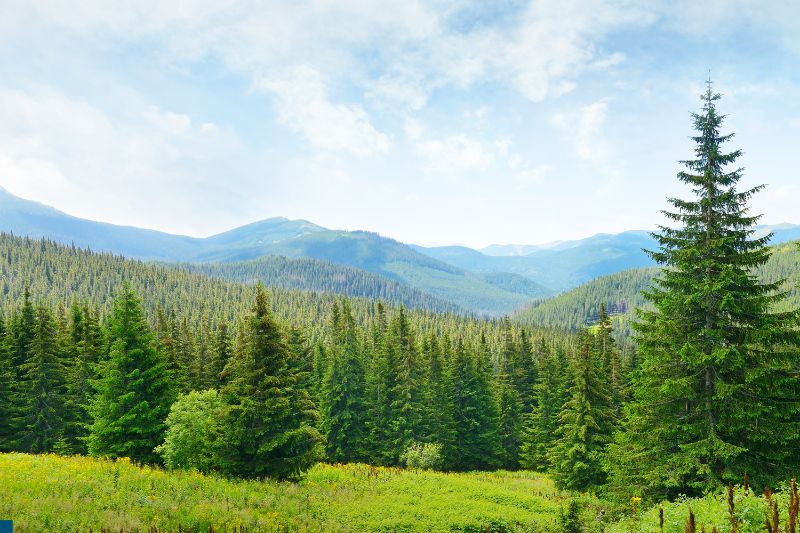Pine trees make great additions to outdoor spaces for a variety of reasons. Whether you are hoping to add year-round pops of color in an area that has snowy winters or you love the iconic pine tree smell, there is a pine tree for you. These evergreen trees can be found in species that only grow a few feet tall to those that tower over 100 feet in height and everything in between.
Pine tree life expectancy ranges depending on which variety of pine trees you have. However, most pine trees naturally live between 50 to over 450 years old if given the right environment or remain disease and pest free.
How Long Does a Pine Tree Live?
Many homeowners look into pine trees as a way to break up deciduous plants or trees in their garden or landscape design. Since pine trees are evergreen, they offer a pop of green or yellow color against the stark white snow or gray weather of the winter season.
Pine trees come in a variety of shapes and sizes, allowing the homeowner to choose based on their needs and desires, but how long does a pine tree live?
Pine trees are hearty trees that have a lifespan of 50 to 450 years or more! The life expectancy of pine trees varies between types, locations, and environmental factors. However, you can expect a long and happy life for your pine tree, making it a great permanent fixture in your garden or outdoor space.
Pine trees are also relatively low-maintenance plants, and once they are established and mature, they require very little from you to continue to grow and thrive. Make sure the soil is healthy and good quality before planting your sapling pine tree, and water deeply and often until roots establish. As the tree grows, you can feed seasonally with an appropriate fertilizer, but it isn’t always necessary.
How Long Does a Pine Tree Live After Cut?
Pine trees are often remembered and coveted for their use as the traditional Christmas tree. These evergreen trees are cut down, brought inside, and decorated with tinsel, lights, ornaments, popcorn string, and more to celebrate the festive season.
Today, many people have purchased fake decoration trees that they store and bring out each season. Others have stayed true to the traditional way and purchase a live pine tree each season.
While the real pine trees create nostalgic memories of going to the tree farm and bringing home a tree, they aren’t meant to last. Living trees, once they are cut from their root system, begin to die. Similar to cutting flowers in a vase, they won’t last as long in water as they do in the ground. So how long does a pine tree live after being cut?
Pine trees will continue to thrive if watered properly for about 4-6 weeks after being cut. Keeping the tree properly watered is vital to prevent it from drying out. Dried-out Christmas trees can become a fire hazard as they can easily ignite if an open flame catches them.
Some people think that fake trees being used each year are more environmentally friendly than purchasing a live tree that needs to be cut down and die. However, purchasing a live tree from a local tree farm can also be environmentally friendly since the tree is a natural product that can be used as firewood, composted, or will naturally break down.

Most Popular Types of Pine Trees
Pine trees are some of the most iconic trees you see. Many people associate pine trees with Christmas, camping, hiking, wooded areas, and other outdoor experiences. While they all look similar, there are actually about 150 types of pine trees!
Eastern white pine, golden pine, Italian pine, Norfolk Island pine, and Lodgepole pine are some of the most popular and famous pine tree types in the wild.
Eastern White Pine
The eastern white pine can live between 100-200 years and is native to the eastern part of North America. However, this pine can also be found commonly in Kentucky.
If the tree is found in the wild, it can grow over 150 feet tall with a spread of 20-40 feet and live for as long as 450 years but generally live for about 200. However, in yards and gardens, the lifespan is closer to 100 years.
Golden Pine Tree
The golden pine tree generally lives between 60-90 years and is more often known as the Wate’s Golden. This pine tree is native to the Appalachian Mountain region and is a variation of the Virginian pine. It grows 15-30 feet tall and has a spread of about 20 feet at maturity.
Italian Pine Tree
The Italian pine, also known as the Italian stone pine tree, lives between 50-100 years on average. The tree is 40-80 feet tall at maturity, which takes 20-30 years to achieve. It is most commonly found in western America, like California and the Mediterranean.
Norfolk Island Pine Tree
Native to Australia and Norfolk Islands, the Norfolk Island pine can grow up to 200 feet with pine cones that weigh up to 15 pounds each. This pine tree can also be grown indoors, maxing out at about 5-6 feet in height. In semi-tropical areas, like Florida, the Norfolk Island pine can thrive but only in well-draining soil. These trees can live for up to 150 years.
Lodgepole Pine
The Lodgepole pine is one of the longest-living pine trees. It can live for up to 400 years if given the proper environment and conditions. You can find the Lodgepole pine growing in the Western United States.
The growth region spreads from the Black Hills of South Dakota to Baja, California, to Yukon, Canada. Despite its impressive lifespan, Lodgepole pines only grow about 156 feet tall.
How To Tell the Age of a Pine Tree?
If you’ve just moved into a home and are curious about the age of trees in your yard, or you’re out on a hike and see a massive pine tree and want to figure out how long the tree has been there, you may be wondering how to tell the age of a pine tree?
There are a few ways to tell the age of a pine tree, including counting the trunk’s rings, measuring the trunk’s diameter, and counting the whorls. Each approach has its own drawbacks and benefits and ranges in accuracy.
Perhaps the most accurate way to tell a tree’s age is by counting the rings. This is done when you cut a tree down and have access to the inside of the trunk. Each year that the tree has been alive, it grows and creates a new ring as the outside of the tree expands. While this is the easiest way to know the age of a tree, it’s not the most practical as it involves cutting down the tree and killing it in the process.

You can also measure the tree’s trunk diameter. To do this, you need to know which type of pine tree it is so you can find its growth factor. The growth factor is the tree’s growth rate and is specific to each variety.
While this number is an estimate, it will give you a pretty good idea of the possible age range of the tree. Measure the circumference of the tree trunk. Divide that number pi, 3.14, and then multiply that number by the tree’s growth factor number.
If you aren’t into math equations or don’t have a tape measure handy, you can also determine the age of the tree by counting the whorls. Like counting the rings of a trunk, the tree produces a new ring of whorls each growth season.
Whorls are the ring of new branches. While this is a simple way to estimate age, counting the ring of branches from each year can be difficult, especially if you can’t see them all.
How do Pine Trees Compare to Other Trees in the Lifespan?
Choosing what to plant in our yards is important. We need to take into account how long the trees live, our region’s climate, and other environmental factors. The visual appeal of the space is also important, and planting evergreen trees like pine trees can help break up barren landscapes in the winter months. How do pine trees compare to other trees in lifespans?
While pine trees can and do live for a long time, some over 1,000 years, other deciduous and evergreen trees also can live for incredibly long periods. However, the average lifespan of a backyard pine tree is between 100-200 years, and the average lifespan of a deciduous backyard tree is about 80 years.
When it comes to choosing which trees to plant in our yards, many experts say that while it is important to plan and properly place trees away from houses and fixtures, so they don’t cause issues at their mature size, most people are only living in their homes for 13 years before moving.
So while function and safety are important, as removing a mature tree for safety can be expensive, you don’t need to worry much about liking the appearance of your garden space in 30 years.






